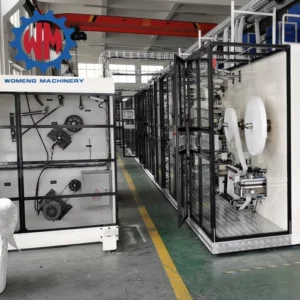In the final inspection phase of sanitary napkin production, several quality control measures are implemented to ensure that the products meet the required standards. Here are some common measures:
- Visual Inspection: Trained inspectors visually examine the sanitary napkins for any visible defects, irregularities in shape, size discrepancies, or issues with the overall finishing.
- Dimensional Checks: Measurement tools are used to verify the napkin’s dimensions, including length, width, and thickness, ensuring they align with the specified requirements.
- Absorbency Testing: Samples are taken from the production batch to test absorbency levels. Various methods, including standardized liquid absorption tests, are used to ensure consistent absorbency across the napkins.
- Weight Measurement: Each napkin’s weight is checked to ensure it falls within the specified range. This confirms uniformity in material usage and absorbency levels.
- Adhesive and Seal Quality: Inspection for proper adhesive application and sealing integrity is crucial. The adhesive should be evenly applied, securing components without excess or insufficient bonding.
- Elasticity and Stretch Tests: If applicable, the elastic components are tested for proper elasticity and stretchability to ensure they meet functional requirements.
- Folding and Packaging Inspection: Inspectors verify that the folding process has been executed accurately and that the packaging is intact, ensuring the sanitary napkins are properly protected and presented.
- Random Sampling: Random samples from the production batch undergo comprehensive testing to represent the entire lot. This sampling ensures a statistically significant assessment of quality.
- Defect Classification and Rejection: Defective products are categorized based on the severity of the issue. Strict rejection criteria are established to ensure that only products meeting quality standards proceed for packaging and distribution.
- Documentation and Record-Keeping: Detailed records of inspections, testing results, and any deviations from quality standards are maintained. This documentation serves as a reference for quality assurance and potential improvements.
- Regulatory Compliance Checks: Ensuring that the sanitary napkins meet regulatory standards and requirements set by relevant authorities.
These quality control measures in the final inspection phase are crucial to ensure that the sanitary napkins leaving the production facility meet the specified quality standards, providing consumers with reliable and high-quality products.
How is the machine designed to handle variations in material thickness or quality?
Handling variations in material thickness or quality in a sanitary napkin machine involves several design considerations and mechanisms:
- Adjustable Tension Control: The machine incorporates adjustable tension control systems that adapt to variations in material thickness. This ensures consistent tension levels across different material types, preventing issues like wrinkling or unevenness during processing.
- Sensor-Based Feedback Systems: Sensors installed within the machine detect material thickness variations. This feedback is used to make real-time adjustments to machine settings, such as tension, cutting force, or positioning, ensuring uniform processing regardless of material differences.
- Precision Cutting Mechanisms: Cutting mechanisms are designed to accommodate varying material thicknesses. Advanced cutting systems can automatically adjust cutting force or blade settings based on detected material thickness, ensuring clean and precise cuts.
- Material Handling Adaptability: The machine’s material handling systems are designed to handle a range of material qualities, from varying softness to different absorbency levels. Roller systems and conveyors may be adjustable to cater to different material characteristics.
- Flexibility in Compression and Folding: The machine’s compression and folding units are designed to adapt to different material thicknesses without compromising the integrity of the final product. These units may be adjustable or have variable pressure settings.
- Calibration and Calibration Sensors: Regular calibration of machine components and sensors ensures accurate processing regardless of material variations. sanitary napkin machine manufacturers Calibration sensors continuously monitor and fine-tune machine settings to accommodate changes in material thickness.
- Material Inspection Stations: Integrated inspection stations allow for real-time monitoring of material quality. Defective or inconsistent materials can be identified early in the process, allowing for corrective action or material rejection.
- Adaptive Programming and Control Systems: The machine’s control systems are programmed to respond dynamically to variations in material thickness or quality. This adaptability allows for on-the-fly adjustments to optimize processing parameters.
- Material Feeding Mechanisms: Feeding mechanisms are designed to handle variations in material properties. For example, adjustable feeders or tension control mechanisms ensure smooth and consistent material feeding, minimizing disruptions due to varying material qualities.
By incorporating these design features and mechanisms, sanitary napkin machines can effectively handle variations in material thickness or quality, ensuring consistent and high-quality output regardless of the inherent differences in the materials being processed.
